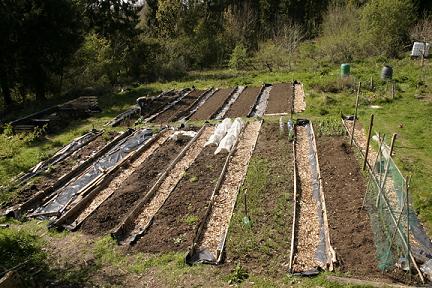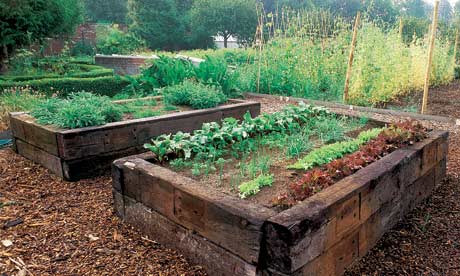|
Search this site for keywords or topics..... | ||

Custom Search
| ||
Raised Beds

Raised planting beds have been our workhorse for a number of years, for several reasons:
1) raising the beds slightly above grade, even only a few inches, allows
for better oxygenation, better drainage, and warmer soil temps earlier
in the year. For our cool, damp, Northern growing climate, those
improvements can mean the difference between seeds that geminate on
time, versus rotting in cold soil. It can also keep the warm-season
plants happier during cool, damp turns of weather in mid-summer. We
must hang onto whatever soil heat we can generate here, and raised beds
help us do that.
2) raised beds go hand-in-hand with looser soils with good tilth. There
are a number of ways to raise beds, from installing boards or stone
borders along a small garden bed, to setting up a cultivator to scallop
soil out of furrows and into a central track. Even standard plows can
form raised beds if the field is plowed to turn either towards or away
from each other, thereby forming raised beds with channels on either
side. The method of forming beds is therefore dependent upon your
planting area, but the principle is the same. Get those soils up off
grade, and you've incoporated more breathing area into your root zone.
3) By creating raised beds, via whatever means, we also almost by
default create walkways alongside the beds. These walkways can become
heavy traffic areas without trampling the roots. By deliberately
leaving room between beds for such walkways, we can even lay down either
low-growing cover crops or landscaping fabric, such that we have
smooth, level, non-weedy walkways between beds.
4) While there's no guarantee on this next point, we have generally
found better yields in raised beds. That may be due to better
oxygenation at the root zone, warmer soil temperatures, less root
crowding, and/or the fact that we usually combine raised beds with other
high-density and deep soil preparation methods (see our other pages on
double-dug beds, lasagna gardening, mulch planting, and square foot
gardening). The fact that these methods all dovetail so nicely is what
matters to us. Teasing out the factor or factors responsible for the
improved growth would be an interesting academic question but would
probably not give us much better performance.
5) One of the things that we appreciate more and more about raised beds
is that we don't have to lean over so far to work in them. That
reduction in kneeling starts to add up as the body gets older, and/or as
the number and size of beds gets larger. For those folks who don't get
around as well as they used to, or are on crutches, canes, walkers or
wheelchairs, that raised work surface can mean the difference between
continuing to grow their own food or having to watch from the sidelines.
Whatever the reason, it's a nice feature that helps make gardening
easier on the body.

As the above photos indicate, raised beds can be almost any size which
is practical and functional for the individual grower. The length and
width of the beds is in part dependent upon what you're growing, and
what you're using to form the beds. Most raised beds we've either seen
or worked with are at least 24" across, but no more than 60" across.
That maximum width is defined by the distance you can reach into a bed
from the side, without stepping in the bed in the process. Most folks
can only reach about 30" into the bed from either side, hence the 60"
maximum width. Maximally wide beds, and minimal walkways, will also
maximize the amount of plantable space in any given area. That may seem
like a minor difference, but compare the number of plants you can grow
in a single densely planted bed, versus in rows, and very quickly you'll
see how much area is saved by not having spaces between the rows.
However, there is a tradeoff in comfort when you have to strain to reach
the middle of those beds and you have hundreds of bed length to cover.
Many growers have yielded to a certain amount of comfort versus
efficiency, and use 48" wide beds. They are much easier (and therefore
less fatiguing) to reach across. Similarly, a slightly wider walkway
(at least 24") is a lot easier to use when steering wheelbarrows,
driving small scale implements, and pushing/pulling harvesting bins.
Raised beds may not be wise to use in certain growing conditions. For
instance, if your soils are hot and dry to begin with, and/or have
difficulty holding onto moisture, then raised beds would magnify those
issues. If that is only a seasonal problem, addition of plentiful
organic matter in the form of plowed-under cover crops, applied compost
or heavy mulch may allow for the best of both worlds - warm dry soils in
spring and fall, yet shaded, moist soils in the heat of summer.
For more information about using raised beds in either small-scale or
large-scale applications, check out the following resources:
Colo State Univ Raised Beds
Univ of MO Raised Beds
Texas A&M Raised Beds
Univ of Alaska-Fairbanks Raised Beds
UC Davis Raised Beds
Univ of Tenn Raised Beds
Wash State Univ Raised Beds
Books about Raised Bed Gardening
The boundary is very fuzzy between raised beds and double-dug beds,
along with intensive planting in either type. Accordingly, the books
that talk about any of these approaches will often jump back and forth
amongst the various traditional and modern sources of information about
these approaches. Thus there is no one book about raised beds, per se.
On my double digging/intensive planting page, I list one of sustainable gardening's classic reference books, John Jeavon's How to Raise More Vegetables....
He certainly has done a lot of work on promoting that approach. Yet
there are other writers who have also done considerable service to the
farming and gardening communities with their own works. Here I list a
few of them, in no particular order. All of them use raised beds and
intensive planting in some way shape or form. All of them deserve
recognition for the work they've done, helping folks feed themselves and
others.
The New Self Sufficient Gardener by John Seymour
This is another one of my favorite books of all time. Where John Jeavon's How to Grow More Vegetables... is a veritable encyclopedia of information, John Seymour's New Self Sufficient Gardener
is a bible. Seymour speaks not merely to our growing minds and hearts
but to our grower souls as well. His writing, and the gorgeous
illustrations throughout the book, remind me why I love growing things.
When I'm laying out my garden plan for the year I'll pull How to Grow More Vegetables...
off the shelf for all the data it has. But when it's cold and raining
and dreary outside and the spring can't get here soon enough, I'll pull
out Seymour's book and slowly page through it, stoking my faith in the
growing year to come. Happily, it is also chock full of information,
some of which is good-old-fashioned growing hints from a man whose
garden was his primary source of nutrition for many years. I wish John
Jeavons taught at the nearby college. But I wish John Seymour lived
next door so that we could visit over the fence. His The New Self Sufficient Gardener is the next best thing.
Season Extender Books
Sponsored Products
Our Successful Farming and Ranching Books

We released our very first self-published book. The Chicken Coop Manual in 2014. It is a full color guide to conventional and alternative poultry housing options, including 8 conventional stud construction plans, 12 alternative housing methods, and almost 20 different design features. This book is available on Amazon.com and as a PDF download. Please visit The Chicken Coop Manual page for more information.

Rabbit Colonies: Lessons Learned
We started with rabbits in 2002, and we've been experimenting with colony management ever since. Fast forward to 2017, when I decided to write another book, this time about colony management. The book is chock-full of practical information, and is available from both Amazon and as a PDF download. Please visit the Rabbit Colonies page for more information.
The Pastured Pig Handbook
We are currently working on our next self-published book: The Pastured Pig Handbook. This particular book addresses a profitable, popular and successful hog management approach which sadly is not yet well documented. Our handbook, will cover all the various issues involved with pastured hog management, including case studies of numerous current pastured pig operations. If you have any questions about this book, please Contact Us.